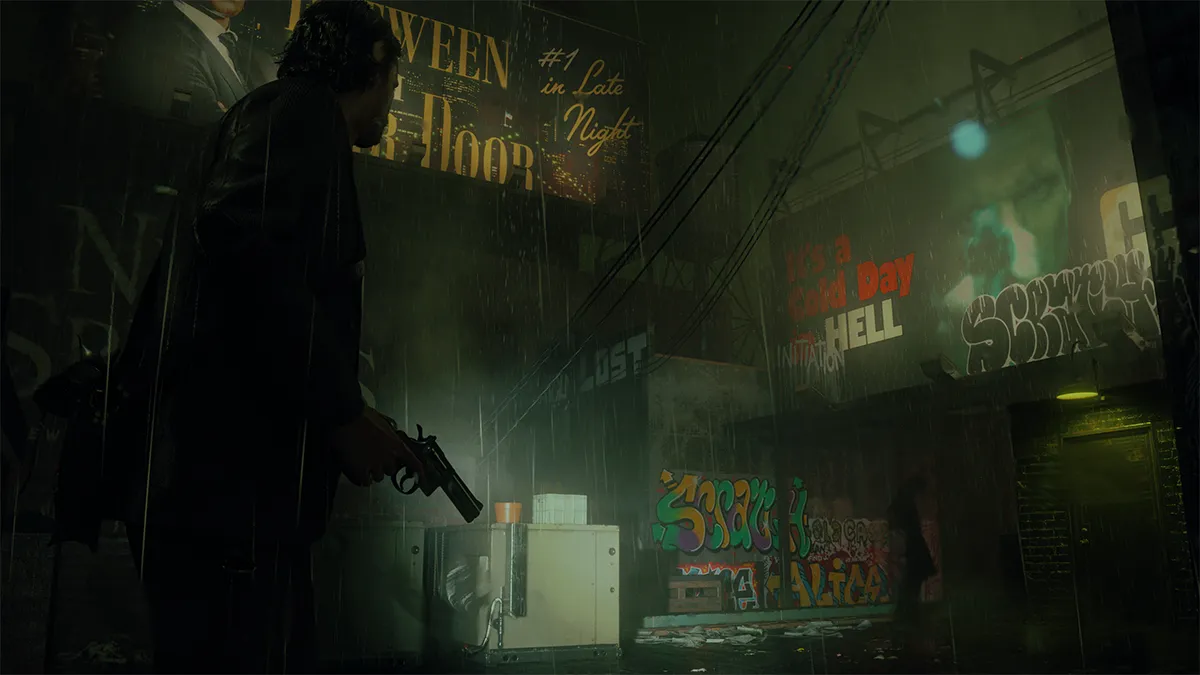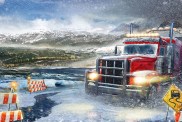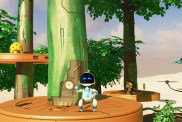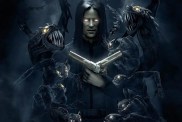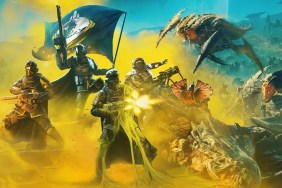Alan Wake 2 is shaping up to be something special, and, according to creative director Sam Lake, that’s exactly the point. Lead gaming editor Michael Leri spoke to Lake about the game, how it benefited from coming out now, why being different is paramount of Remedy Entertainment, the metaphors in Alan Wake, and more.
Michael Leri: Is it hard to take out time at the very end of development to market a game?
Sam Lake: Getting a game done is always — and certainly now — a mad rush. This is bigger than any other Remedy game. This is 20 plus hours and bigger than Control. A lot of polish, a lot of fixing, a lot of optimizing; that always is a crazy rush at the end. Then, on top of that, of course, it makes sense to go around and show the game and talk about it.
I hope the game sticks out. That’s a big part of how we approach these. We feel that we need to do something that looks like us, stands out, is unique, and is something different because there’s a lot of competition out there and we can’t do the same thing that somebody else is doing. A lot of thinking goes into how we can make this exciting and something that people will go in and go, “I have never experienced something like this before.”

So what makes Alan Wake 2 stick out?
I think it will be a very unique balance. It is a survival horror game. Obviously, you can see an echo of Resident Evil there, like in resource management and all that. But at the same time, it is still an Alan Wake game in the sense that it’s not just all-out horror, as many horror games tend to be. It’s dark and horrifying from the get-go and all the way true [to Alan Wake].
And for us, it was important to have all of these different sides to it. You get to explore Watery and Bright Falls during the daytime. Deer Fest is about to happen, so there are locals setting up their banners. The game takes place this year in 2023 in September because that’s what we set up to be the annual date of Deer Fest. And here we are again only 13 years later and things have changed along the way quite a bit in many different areas.
But this is a balancing act. There is the idyllic small town, beautiful vistas, quirky larger-than-life locals, and plenty of humor. And at the same time, it is a horror game and when the night falls, and when we go to the dark forest or in the Dark Place, there is definitely horror there.
That kind of a balancing act is very important for us. It has all of these different sides to it and then we think how we can be as ambitious as possible with interactive storytelling. And a big part that is new to us here is bringing the story closer to gameplay, which goes to the Mind Place and profiling and the case board, writers room, and plot board. These are actual mechanics that have you interact with the story.
I feel that we couldn’t have done this [before now], like if we had been lucky with our wish to do Alan Wake 2 and it would have ended up going forward, all the earlier concepts were very different from this. I don’t think that we could have made this game before we made Control.
Lessons learned from Control affected this quite a bit. Tonally in some ways but also how we build the world and the progression through it.

Remedy is making a ton of games, right? How does that even happen within one studio?
With a lot of complexity. Remedy has been growing a lot. We are 400 or so people. With Alan Wake, it’s been around 130 working on it. There are other teams at Remedy working on other projects, and Alan Wake for a while now has been the one that has been in full production mode.
The others are still in concepting, pre-production, or in other phases where the team size hasn’t been built to the maximum production level yet. The plan is to have them in different phases and so when people get off from this, they go to other teams to help them out as well.
What about you?
I’ve been really, really fully on [Alan Wake 2] for multiple years. I have loved working on this. I’ll be involved in the DLC coming up, and then I think I’m going to take a bit of a vacation. It’s been a lot of work for quite a while. And then coming back, we’ll see what makes sense. I’m trying to [avoid burnout].

You’ve come a long way from writing like text and Death Rally. And the team’s writing has gotten so much more complex. How do you feel about that growth?
It’s worth underlining that it’s always a collaboration. Making games is a team effort. We do have a writing team and narrative team looking at the story and thinking about it.
There have been a lot of learnings along the way and growth, and it’s important to tap into that and take all of those learnings and put them into action. Maybe it was partly because this was so long and kind of a dream of being able to come back to Alan Wake 2, but when it was finally happening, there was almost this feverish push to do more and do everything.
There was this excitement and many elements that we have dabbled with in earlier games. Here it was like, “How can we make this bigger and cooler and turn the knobs to the max?” Certainly, under the hood and when you start exploring and go deeper, it has a lot of the weirdness from Control, but pushed into the direction that fits with Alan Wake’s story. We use different mediums, like in the first game. There were manuscript pages and pages of a novel.
We brought them back and have fun with them in various ways, like the live-action scenes. But with the Dark Place being a dreamy reality, we had to figure out how we can stylize it so that it’s a more seamless part of the experience and makes you feel unbalanced in some ways so you don’t know what’s going on.
We have projectors and TVs in the world and you can interact with them. And we are pulled in and Alan Wake is pulled in and he finds himself in this scene and he’s confused, but then it plays out, and at the other end, we have a similar transition where it’s back to the world or into a deeper level of the Dark Place. Music is also something that we have and custom songs.
Now, this time around with something like that, we are doing more than ever before. We are taking all of these elements that have excited us and figuring out how we can push them further.

The Ashtray Maze in Control feels like it was also part of that mindset.
Not saying that this is in any way confirmation, but we are trying to top ourselves, which is a nice interesting challenge.
Alan Wake has always been a metaphor for the creative process. Was that a conscious thing bred from the stress of creating games? And how much of yourself do you see in Alan Wake?
I think it’s a fact that everyone who writes or creates draws from their experiences and emotions. To me, the first Alan Wake felt like a metaphor of having to follow up success. He reached huge success writing crime books with Alex Casey and Remedy reached huge success with May Payne. Needing to find a new direction is always a struggle.
On that level, I always felt that there was something interesting here. Alan Wake being a writer’s journey, in some ways, felt that it could pull from the idea of the creative process overall and that ended up being part of it.
If we look at Alan Wake and the fact that we are proceeding in real time through our connected universe, at least after this point, he has been stuck in the Dark Place for 13 years and we’ve been trying to make the sequel for 13 years. And he’s been writing and writing and doing drafts of the story to escape, but it keeps failing and he keeps starting again. So certainly there is a kind of a twisted mirror there to have fun with. There are quite a bit of meta elements in Alan Wake 2.

Control had a little bit of ambiguity in it, where it left just enough out. How does Remedy balance that here in Alan Wake 2 so players are intrigued but not too confused?
Yes, that was really important in Control. It’s always been in my mind when writing stories. Like the original Alan Wake starts by saying unanswered mysteries are what stays with you the longest. To me, that is an important part of it.
Because we have these two narratives floating side by side with Saga in the Pacific Northwest and Alan Wake in the Dark Place. They’re very connected, but you are free to proceed as you choose and nothing is spoiled. You get a different perspective and some things are foreshadowed differently, and some are called back to in a different way, but it requires a certain sense of ambiguity and dream-like understanding or not understanding certain things that are not spelled out. In a linear story, it would be you playing Saga up to this tricky cliffhanger, and then you would move to Alan Wake.
But Alan Wake 2 isn’t set up like that. They connect in many places, and if there are cliffhangers, they are in their own paths separately, but never across [the two campaigns] because that would force us into a linear approach. It just feels like a fresh angle of interactive storytelling and experimental enough for us to try out different things and iterate.
I do feel that his opening statement in the first Alan Wake has not gone anywhere. It’s an opening statement of Alan Wake as a franchise, and so we are definitely going to keep on doing that.
